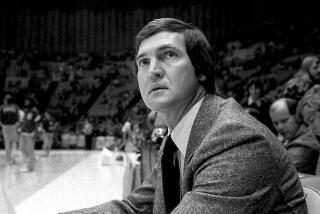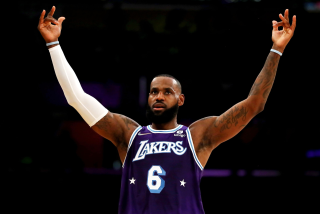Got Game, Got Sore Muscles
- Share via
I’m 40 now and close to accepting that I’ll never make it in the NBA.
It’s not just that I’m slow, can’t jump and am a less-than-stellar free-throw shooter (just like Shaq). It’s that I’m out of practice. At least I’m pretty sure that’s the only reason.
I haven’t run a full-court game since the morning of my wedding more than five years ago. My goal that day was simple: Survive to say my lines. So when asked recently to do a column about pickup basketball, my goal was essentially the same: Survive to write these lines.
I say survive because after being a lifelong basketball player my ankles feel as if they are made of papier mache. My knees feel as brittle as chalk. And the only Walton my game feels like is Grandpa, not Bill or Luke.
But the pull of the courts is strong. I practically grew up on basketball in North Carolina. When I was a kid, there weren’t any local pro teams to speak of, and college hoops was a near religion. Most autumn and winter days after school were spent in the backyard or a local community center honing jump shots or perfecting the pick ‘n’ roll.
As an eighth-grader, I attended Dean Smith’s basketball camp in Chapel Hill. It wasn’t based on merit. I had a friend whose father was a generous donor to the university. Instead of Smith, the legendary former coach of the University of North Carolina Tarheels, we got one of his assistants, Roy Williams, who turned out to be no slouch himself.
Williams, now head coach at the University of Kansas, taught us all about “Carolina basketball,” which stressed the fundamentals: passing, dribbling and shooting. But above all, Carolina basketball meant unselfishness. How to set picks, how to hustle on offense without the ball and how to hit the open man.
In short, we learned all the skills that are next to worthless in a pickup game. That lesson was brought home to me yet again as I played one recent afternoon at the Ketchum YMCA in downtown Los Angeles.
The courts at the YMCA are outstanding. The hardwood floors are well maintained and wonderfully squeaky, if lacking that smoky old gym charm I recall from the movie “Hoosiers.” Not surprisingly, it gets crowded. During the lunch hour and after work, both mini-full courts are usually bustling with action and a bunch of (mostly) guys waiting in the wings to play.
When I went one midweek afternoon, there were only enough people for a half-court game. Within 30 minutes, more players arrived and we moved to a full-court game.
The age range of players was probably from 14 to 50 or so, but most seemed to be in their late 20s and early 30s. The skill level was fairly competitive. One sure sign of decent players: no sandbaggers (guys who linger near their own basket while everyone else scrambles to the other side of the floor to play defense).
To fulfill the fitness portion of this column, I was supposed to wear a heart-rate monitor. I was a little nervous about this since its discovery would mean certain ridicule from strangers. If we went to shirts and skins, I had an excuse ready: I have a heart condition. Luckily, everyone kept their shirts on and nobody seemed to notice the monitor.
I stretched before the game and was fairly confident that even though I hadn’t run the courts in a while, I’d be fine. I’m in pretty good shape. I do a 30-minute cardiovascular workout at least four, sometimes five, times a week without much trouble.
After about 10 minutes, I realized that I was indeed in good shape, as long as I stuck to exercise machines. I am in what you might call “elliptical trainer shape,” not “full-court basketball shape.” I was using all kinds of muscles that apparently had been sleeping during my cardiovascular routines.
My heart monitor was programmed to beep if I rose above or fell below my target heart rate zone, which indicates whether I’m training too hard or not hard enough. Well, my ticker was racing so much that when I shuffled back on defense I must have sounded like a truck in reverse. Luckily, my loud and labored breathing drowned out the beeping sound.
In about an hour of playing, I was--despite the many ups and downs on the court and in my heart--within my target heart rate for almost 45 minutes. There were momentary breaks during games or breaks between games when disagreements arose over the score or fouls. But all in all, a very vigorous workout.
I tried to ignore my body’s urgent pleas for more oxygen and practice the basketball fundamentals I’d learned so long ago. I set picks, I boxed out, I passed.
My teammates, however, didn’t really play that kind of ball. Their style might best be summed up as: “If I touch it, I will shoot it.” By the end of the third game, I was launching long shots from the perimeter too.
I didn’t have the energy to do much more. As it got close to the end of the hour, the only fundamental I was trying to practice was simply standing up and moving my cinder-block legs as best I could.
Though age may have withered the body, it has developed the mind. When matching up for the full-court game, I chose the most tired-looking guy I could find. We both were grateful for the other’s poor physical condition.
Luckily, my ankles and knees remained intact. The next day, however, an assortment of leg and neck muscles felt as taut as the cables on the Golden Gate Bridge. As much as I hate to admit it, this experiment has taught me that I can rule out an NBA career. That is, unless I’m hired to guard Shaq.
*
Times staff writer Martin Miller can be reached by e-mail at martin. miller@latimes.com.
*
(BEGIN TEXT OF INFOBOX)
Snapshot: Basketball
Where to go: Stuart M. Ketchum Downtown YMCA (nonmembers must pay a $25 entrance fee)
Duration of activity: 58 minutes (brief breaks between games)
Calories burned*: 913
Heart rate*: Average of 132 beats per minute; high, 178
Target zone: 117 to 153
Time in zone*: 44 minutes
* This information was obtained using a heart-rate monitor. Time in the target heart-rate zone is a measure of the intensity of the workout. Target zone varies based on age and individual heart rate.
More to Read
Go beyond the scoreboard
Get the latest on L.A.'s teams in the daily Sports Report newsletter.
You may occasionally receive promotional content from the Los Angeles Times.










